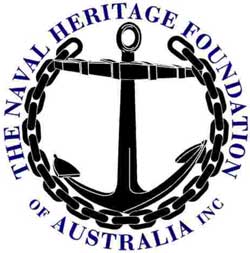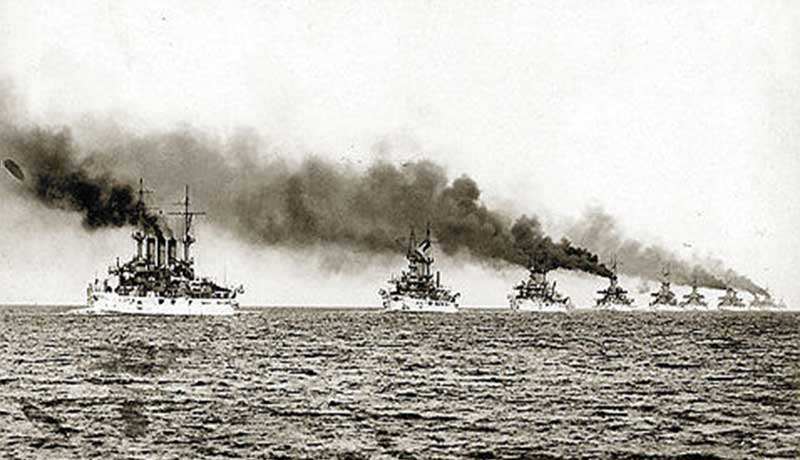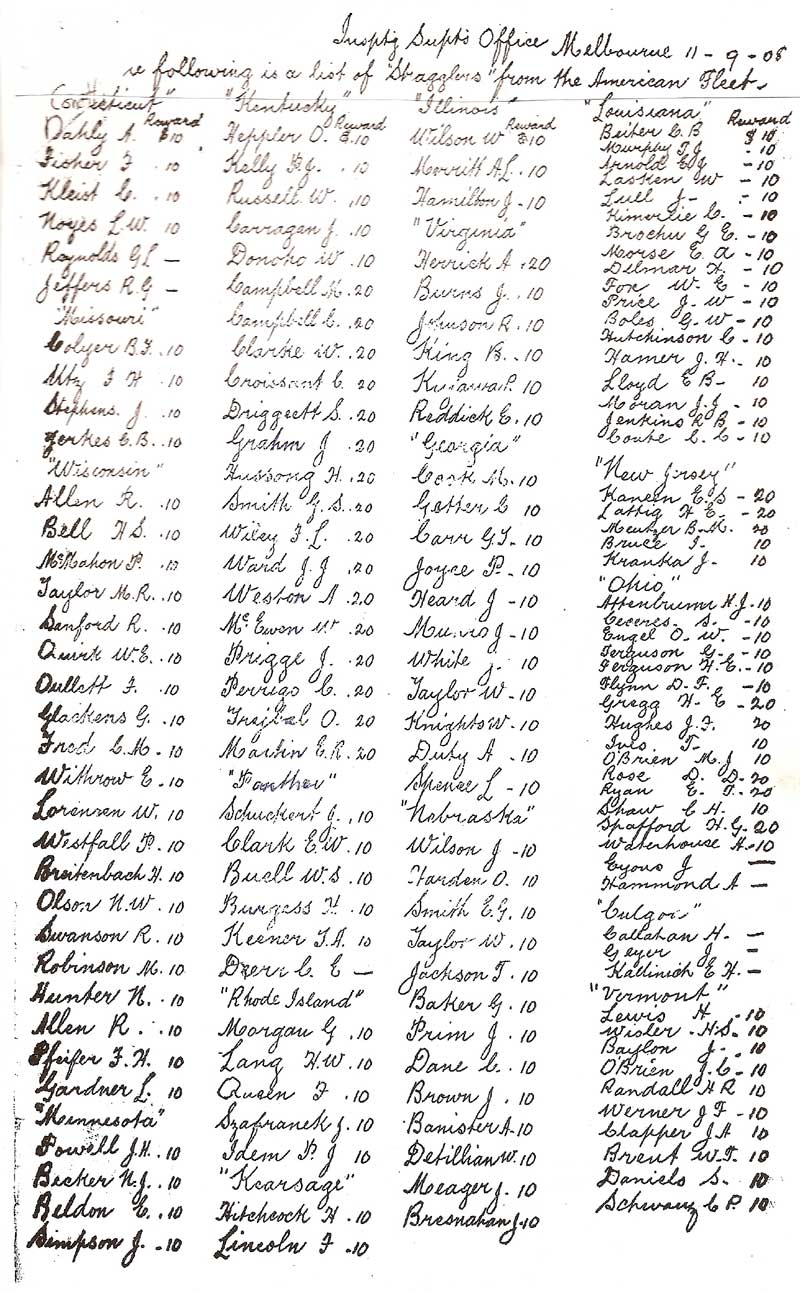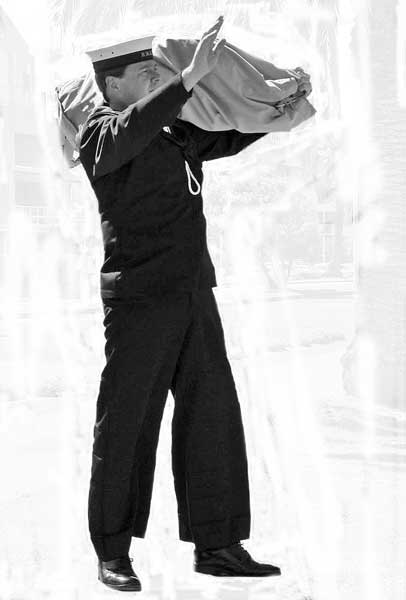|
The Victorian Colonial and Royal Australian Navies, and the visit of The Great White Fleet to Australia, August 20, to September 5, 1908
Here is the presentation. See the Powerpoint file, 6 meg. The Victorian Colonial and Royal Australian Navies, and the visit of The Great White Fleet to Australia, August 20, to September 5, 1908. By Mackenzie Gregory. Introduction. Our country was discovered by Captain James Cook in 1770. In 1950 I was appointed Aide-de-Camp to His Excellency the Governor General of Australia, Sir William McKell. At the National Library in Canberra I was able to get my hands on Captain James Cook's original Endeavour Journal to learn from the Entry for Sunday 6th of May 1770.
We were settled, albiet, initially by convicts transported by sea from the British Isles, our imports and exports have essentially used the sea. The oceans that surround us have formed a protective barrier, prior to the development of aircraft we were totally dependent upon the sea for travel to and from the rest of the world. I suggest that we in Australia will always need " To look to the Sea." In the early stages of Australia's development, the Royal Navy provided our shield of defence, but in the main it was based upon Sydney. Discovery of Gold in Victoria. A good deal of this precious metal was shipped off to England, carried in sailing ships. The Victorian government and the local populace of Melbourne were fearful of attacks from both the French and Russians, upon the stored stocks of gold held for future shipment, and on the vessels carrying it off to Europe. Defence of Melbourne and Port Phillip Bay. Naval Reserve training commenced in 1855 with the formation of the Sandridge and Williamstown Companies of the Victorian Naval Brigade. By 1864 there were 68 pounder batteries mounted around the Bay, eg the Sandridge Lagoon battery, Emerald Hill Central battery, Emerald Hill Advanced battery, St Kilda battery, Breakwater Pier battery, Right battery, Lighthouse battery at Williamstown near the Railway Pier ( the largest of them all, with 8 by 68 pounders ). At the entrance to Port Phillip Bay, at both Point Nepean and Queenscliff. There were opinions aired that the Russians were merely testing out our defences at the entrance to Port Phillip Bay! Confederate Raider Shenandoah. Melburnians flocked to view the raider who also was quietly attempting to recruit crewmen, but the Victorian Government sought to ignore such reports. Amongst the locals, some were for the Raider, others against her. In fact about 42 men were actually recruited and were transported in four boats from Sandridge beach. ( eluding a police presence ) Neutrality breach. Shenandoah continued to attack shipping in the Pacific, and was not aware that peace had been declared, as she sank a number of US vessels after the war was over. A newspaper captured from a ship that was sunk provided Captain Waddell with the first news that The American Civil War was actually over. This warship had been the former Sea King, bought by Confederate Agents in London, and sailed to Madeira to be fitted out at sea with her 8 guns, and renamed CSS Shenandoah. Early Victorian Governor. Sir Charles served for but a short period, from May 22 to December 31, 1855. Victorian Colonial Navy. She served over 1860-61 in New Zealand during the First Taranaki War, thus becoming the very first Australian unit to serve in an overseas war. From the early days of settlement in Victoria the importance of Sandridge ( the former name for Port Melbourne ) in its defence was clearly recognised. A site on Sandridge beach would be an ideal location for a gun powder reserve, and in 1861 an area of the beach near the lagoon (the future site for building HMAS Lonsdale) was reserved for Military purposes. HMS Nelson. Britain agreed to pay 80% of her costs. The new ship arrived on station in Victoria in 1871, carrying 10 inch guns. It is a tragedy that this Monitor, the only survivor of its type world wide was sunk as a breakwater off the beach of the Melbourne suburb of Blackrock. She was allowed to rot, and an attempt to preserve her at this late stage now underway, may prove to be too late. In 1883, two First Class Gun Boats, two Second Class, and one First ClassTorpedo Boat were ordered at a cost of 84,200 Pounds. The Victorian Colonial Navy ships bore names such as: Victoria 11, Albert, Childers, Lonsdale, and Nepean. The threat from French and Russian warships was very much in the minds of the Victorian Government, and a number of Merchant Ships were fitted out as auxiliary warships. A minelayer Miner, the Melbourne Harbour Trust hopper barges Batman and Fawkner, the tugs, Gannet and Eagle, the Yacht Commissioner, and the Launch Spray. 1886 saw the arival of the Turnabout Torpedo Boat, launched as Gordon, designed to turn rapidly in the water after discharging her torpedoes. Lady Loch, the Victorian fleet's largest auxiliary also came into service in 1886, fitted with one 6 inch gun plus two one inch Nordenfelt guns. On May 25 1889, the auxiliary Yacht Vulcan was launched off Williamstown, a 75 ton mine layer, she transferred from Navy control to the Permament Engineers, as the Army was responsible for controlled mine laying, from this distance that appears an odd decision, Naval mining at sea run by the Army! But I parade my bias. It is an interesting fact that from a Defence Budget for Victoria in 1890, of the 145,000 Pounds total, the Navy scored 32,000 Pounds 6 shillings and 4 pence, I found myself pondering on the 6 shillings and and 4 pence, what would that bring to our Naval defence? Countess of Hopetoun was laid down in 1890 at the Yarrow and Company yard in UK, the last ship to be ordered for the Victorian Navy. She was to have a top speed of 24 knots, and was the largest and most powerful Torpedo Boat in all of the Colonial Navies. This vessel was also the first to feature a twin and rotating torpedo mounting. In 1895 both Albert and Victoria were withdrawn from service, plus the auxiliary gun boats and Nelson was already in reserve. The colony of Victoria now only operated Cerberus and five torpedo boats. Federation. Melbourne became the location for the administrative head quarters of the Commonwealth Government, the Department of Defence which was headed by Captain Muirhead Collins as the new Permament Secretary ( formerly Secretary of the Victorian Colonial Defence Department ) The Commonwealth Naval Forces ( CNF ) under its Director, Captain W. R. Creswell CMG, CNF. were also located in Melbourne. Ballarat Boy's Naval Brigade. Beyond Federation. The first brick building erected in 1912 for the RAN in the Commonwealth was the Drill Hall adjacent the old Post Office ( I took my Medical as a candidate for the Royal Australian Naval College there in 1935 ) The Drill Hall now became the new Port Melbourne Naval Reserve Depot ( PMNRD ) and all training was carried out there until the outbreak of WW2 when it Commissioned as HMAS Cerberus 111, but with three separate naval establishments all carrying the same name, and only distinguished by the next Roman numeral, absolute chaos reigned, and in July 1940, Cerberus 111 became HMAS Lonsdale, named after Captain William Lonsdale the first Agent General of the Government, and the Police Magistrate of Victoria. Japan and the United States, early 1900's. Japan had been victorious against the Chinese and the Russians both on land and at sea respectively, many in the US believed that the US west coast and Hawaii were vulnerable to attack from Japan. President Teddy Roosevelt considered that a show of strength by his Navy might deter the Japanese, he ordered his Atlantic Fleet to undertake a world wide cruise, and now named the Great White Fleet, all the ships were painted white, and consisting of 16 Battleships manned by 14,000 sailors sailed from Hampton Roads, farewelled by their President in his Yacht Mayflower, on December 16, 1907, to commence a voyage that lasted till February 22 in 1909. As the Panama Canal was still unfinished, the fleet needed to sail round Cape Horn to enter the Pacific Ocean. Over the 15 years before the Great White Fleet sailed on its historic world wide cruise, in the Pacific Ocean the balance of power was shifting, from the Sino-Japanese war 1894-95, and the Russian- Japanese conflict 1904-05 the pendulum had swung to a strengthening Japanese Navy in the Pacific. The Russian Navy was destroyed at Tsushima, the French Navy was in decline, the British had withdrawn their Battleships, leaving Japan with the biggest single fleet in the Pacific Ocean. This was of great concern to President Teddy Roosevelt, hence his orders to the Great White Fleet. Australia, Britain and the Great White Fleet. But both the British and Australia were really working from different agenda, the British Admiralty wanted Australian ships to act as they were required to suit the needs of the British Empire. The Australian Prime Minister, Alfred Deakin wanted more independence for the infant Australian Navy, he sought to put Australia's needs and its defence as his primary priority. He pre empted the Australian WW2 Prime Minister, John Curtin, who after the Fall of Singapore in 1942 turned his eyes to the East to the United States for both alliance and support. Alfred Deakin ignored the Colonial Office in London and contacted President Roosevelt to invite his Great White Fleet to visit Australia, he agreed that his ships would visit Sydney, Melbourne and lastly Albany to coal for the next leg of their voyage. This was the commencement of an alliance between Australia and the United States that still flourishes in 2008, in 2001 we celebrated the 50th. anniversary of the ANZUS treaty. To mark that event, at the Washington Navy Yard on September 10, 2001, President George W. Bush presented the ship's bell from USS Canberra ( named after HMAS Canberra, sunk at the Battle of Savo Island on August 9, 1942.) to the Australian Prime Minister John Howard. I had been sunk in HMAS Canberra, and my son Raymond had been christened aboard USS Canberra, alongside at Station Pier on Mother's Day in 1967, using this bell as the christening font. Both my wife and myself were present in Washington for the impressive bell handing over ceremony.
The British Press. Australia was not expected to be the petulant child stamping its foot as we were not getting our own way. Colonials should be aware of their proper place within the heirachy of the Empire. Let me go forward to 1940, I was serving in HMAS Australia attached to the British Home Fleet, we had been seconded to the Royal Naval force supporting General Charles de Gaulle's debacle at Vichy held Dakar on the west coast of Africa. Australia had twice been hit by French shells, had our Walrus aircraft shot down, lost her three crew, and sunk a Vichy destroyer. We were in a dry dock at Liverpool in December, and subjected to a number of heavy raids by German bombers. I was taken home for a weekend by an English Wren whose Father was the MP for Birkenhead, her rather formidible Mother who certainly believed the family belonged to the Upper Class, found me cleaning my shoes, she snatched them from me with " Naval Officers do not clean shoes, we have servants to do that." I was due 10 days leave, Mother said, "We must send you away from Liverpool and all the bombing, we have friends on a farm in Wales, that will be much safer for you. I protested that I should not be thrust upon the family, oh replied Mother " Don't you worry at all, they are Canadians, only Colonials, just like you." Back to the Great White Fleet. Composition of the Great White Fleet. 2nd. Division. USS Georgia, divisional flagship, US ships, New Jersey, Rhode Island, Virginia. 3rd. Division. USS Minnesota, divisional flag ship, US ships, Maine, Missouri, Ohio. 4th. Division. USS Alabama, divisional flagship, US ships, Illinois, Kearsange, Kentucky. Fleet Auxiliaries. USS Yankton, tender. Torpedo Flotilla Destroyers. Arethusa, torpedo flotilla tender. New Zealand. Now it sailed for Sydney Australia to arrive in that city on August 20 for a 7 day day visit. Sydney viewed the visit of the Great White Fleet as a sign that any aggresive move from the Japanese Navy would be thwarted by an American Fleet. As the Russians had been defeated, and the British had also vacated the Pacific, the remaining vacuum could only be filled by America. A local comment was, we have never seen a single British battleship here, now we suddenly have 16 battleships in Sydney Harbour. Their reception was overwhelming. Allow me to quote from James R. Reckner's book: Teddy Roosevelt's Great White Fleet,
Finally on August 27 the Fleet disengaged itself from Sydney's embrace and sailed out through the Heads to turn south and head for Melbourne. When the Fleet sailed, 91 men had failed to report, but USS Yankton had stayed behind, and when she proceeded, 60 of them had come aboard, the remainder stayed in Sydney. Melbourne Greets the US Fleet. For this visit of the Great White Fleet to Melbourne, the locals knew they would have to excel to top the reception that Sydney had provided for their visitors. On Saturday August 29, 1908, the Fleet entered Port Phillip Bay just after 11 AM. Crowds lined the foreshore, small boats greeted the majestic battleships to accompany them on the 30 miles trip up the Bay, where the Fleet dropped anchor in two lines of 8 ships, off Williamstown at about 3 PM. Melbourne was about to turn on American Week. HMAS Cerberus was anchored at the entrance o the Yarra River, she returned the Fleet's salutes and then saluted Rear Admiral Sperry's birthday. The monitor was now 40 years old, tending to look her age against the might of the United States, she was spawned in a different Naval era. Ballarat Boy's Naval Brigade. The local community raised such a fuss that the Government was forced to provide for them return train travel, so many gifts were showered upon this Naval Brigade, that an extra rail carriage was needed to accommodate it all.
Rear Admiral Sperry goes ashore. The next day, a US Naval Brigade landed at Port Melbourne, marched along dusty roads to the City, thence to parade down Swanston Street, to the cheers of a huge cheering crowd lining the street, people up poles for a better view, others crowding windows overlooking the parade. Freemasons and Roman Catholics. Military Review. 8,000 Victorian Cadets including the Ballarat Boys, and many military units took part. Dinner. With female company in full supply, why would a Sailor want to leave his new found girlfriend to attend a dreary dinner with his shipmates he sailed with every day? From the girl's viewpoint, they were reluctent to give up their exciting escorts to be left alone. The Sailors were feted. Time to leave. The girls hugged and kissed the Sailors struggling to reach the station, their tunic buttons grabbed as a souvenir. It was little wonder that some of the US Sailors chose to take permament leave of the US Navy in Melbourne. On the first count, 85 had failed to return to their ships, this figure was soon revised upwards to 221.
List of deserters from the Great White Fleet in Melbourne, September 1908. It was provided by the US Consul in Melbourne to the Chief Commissioner of Police in Melbourne. Some had 10 Pounds reward placed on their head for being turned in to police, others 20 pounds, and some without any bounty, apparently those were close to the end of their stint in the US Navy, and the authorities were not too worried about their return.
Rear Admiral Sperry was forced to go to the local market to buy more inferior coal to make sure his ships reached Albany where coal was waiting to take the Fleet on its next leg. Time for tears. On Saturday morning, September 5th. 15 Battleships departed, leaving USS Kansas behind to collect any mail and other males still not returned. When she sailed on the 10th. she carried 458 bags of Fleet mail and 100 stragglers. Still ashore and unaccounted for between 100 and 115 deserters. How fascinating it would be to actually track down some of the descendents from those who stayed, and to hear their stories. Visit of the Great White Fleet a huge success. The Sailors later voted that Melbourne turned out to be the best Liberty Port over the entire World tour. Politically, the visit had vindicated Alfred Deakin's decision to contact directly President Teddy Roosevelt to invite his ships to call into Sydney and Melbourne. The visit of this powerful force raised the awareness of Australians to our vulnerability, and the need for a Navy under our own control. We received Royal assent from King George Vth. to prefix Australian Navy with Royal, thus on July 10th. 1911 the Royal Australian Navy came into being. New Drill Hall for Port Melbourne. Any one in Victoria joining the Navy for the duration of Hostilities and a further six months had the prefix PM to their Official Number. PM stood for Port Melborne, they thus carried with them over their career the fact they joined the RAN at Port Melbourne, and thousands would fall into that category. In 1992, Lonsdale was decommissioned, the site was cleared to give way to a high rise apartment block named HMAS. The Bay Street Drill Hall passed from Commonwealth ownership to the then Liberal Victorian Government, who allowed CIRCUS OZ to take possession, they are still in occupancy in 2008. The Long Naval Association with the City of Port Melbourne ends. The Naval Heritage Foundation of Australia Inc. One of its objectives is to erect a 1.25 times normal size bronze Statue of a WW2 Sailor at Port Melbourne, adjacent to the site of the old Town Pier, demolished in 1950. Since the mid 1850's and the Colonial Navy, thousands of naval men and women have served their country in war and peace. There is not a single Heritage Marker to remember all those who passed this way. The Answering The Call Statue will be designed to honour and remember them. I am proud to be President of the Foundation. My thanks for your attention and patience, I will be happy to try and answer any questions.
I am going to be a busy boy with my colleague Don Boyle who is the Foundation Vice President, we are trying to erect a statue of a bronze sailor on the foreshore at Port Melbourne where the Navy had a presence from the Victorian Colonial Navy days from 1859, up to 1992, but sadly no longer, and there is no Heritage Marker to show the Navy was ever there. The last PP slide shows the model we hope to use, cost about $200,000, and I achieved the first donation of $20,000 recently.
The Naval Heritage Foundation of Australia Inc.
We propose to erect a 1.25 times normal size bronze statue called Answering the Call on the foreshore at Port Melbourne to remember and honour all the Naval men and women who have served their country since the Victorian Colonial Navy days in the mid 1850's to the present. Anticipated costs are in the vicinity of $150,000/200,000. Picture of the model to be used by the selected sculptor is attached. |

 In August/September of 1908 the US Great White Fleet of 16 battleships and 14,000 Sailors visited Sydney and Melbourne. To mark this event The Naval Heritage Foundation of Australia Inc. of which I am the President will give a number of public lectures, complemented by a Power Point display of early Colonial and Great White Fleet pictures and Post Cards (
In August/September of 1908 the US Great White Fleet of 16 battleships and 14,000 Sailors visited Sydney and Melbourne. To mark this event The Naval Heritage Foundation of Australia Inc. of which I am the President will give a number of public lectures, complemented by a Power Point display of early Colonial and Great White Fleet pictures and Post Cards ( 

